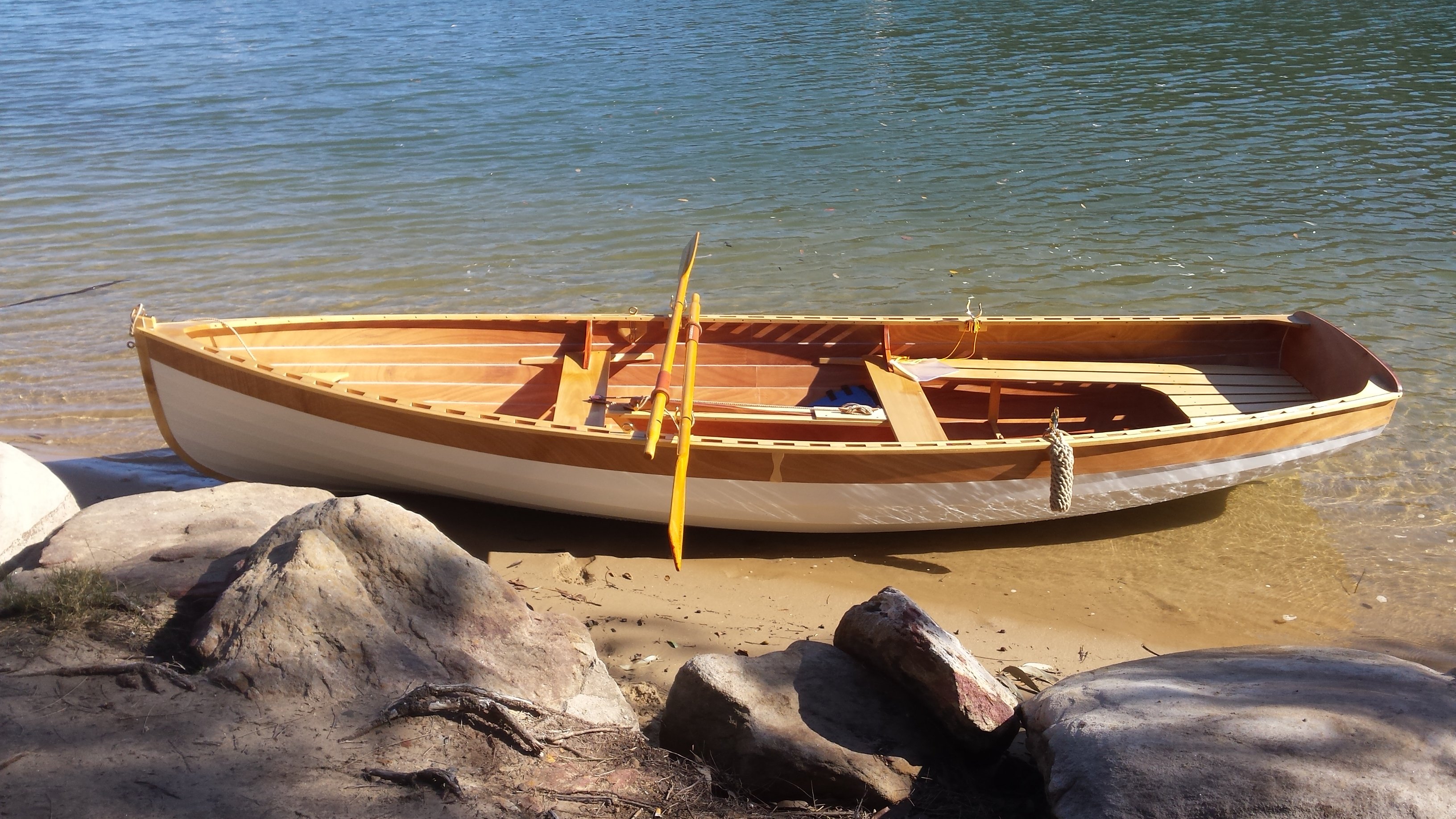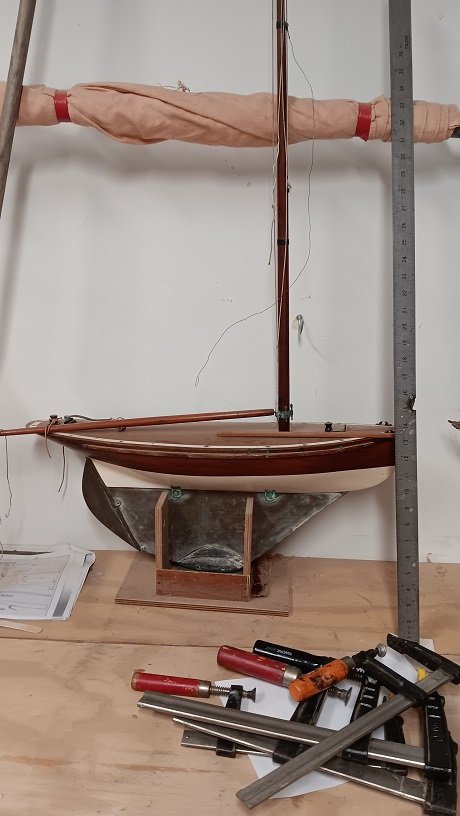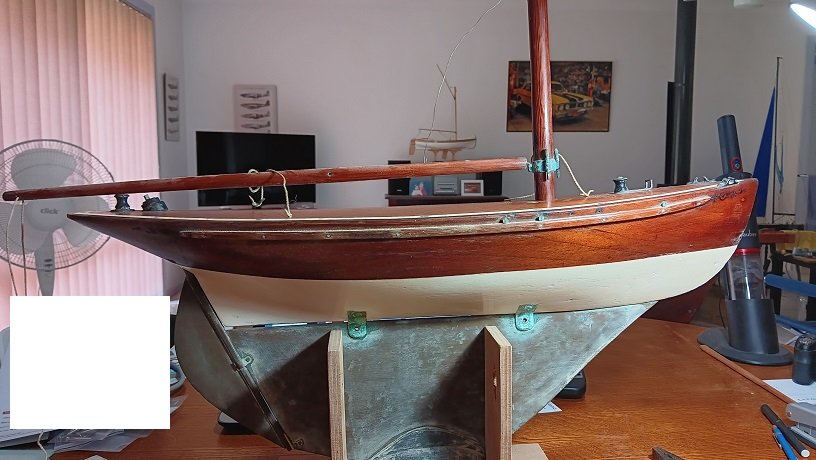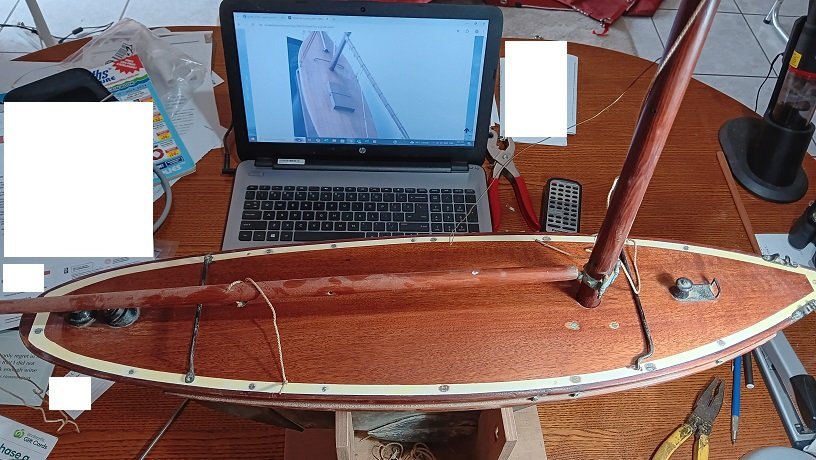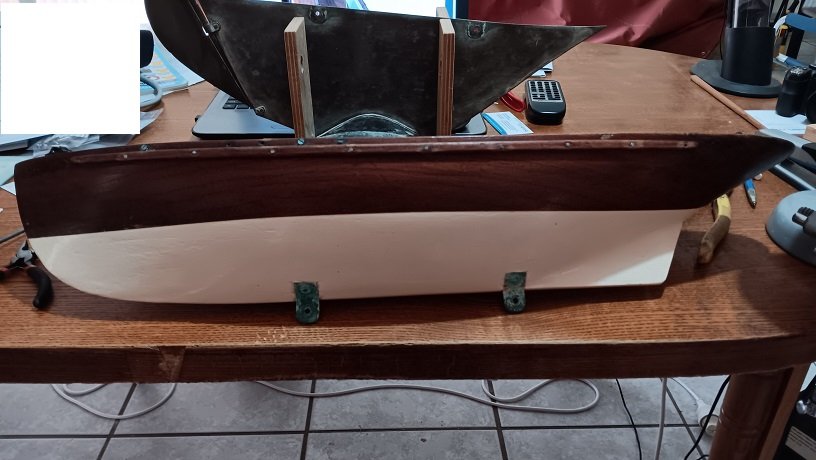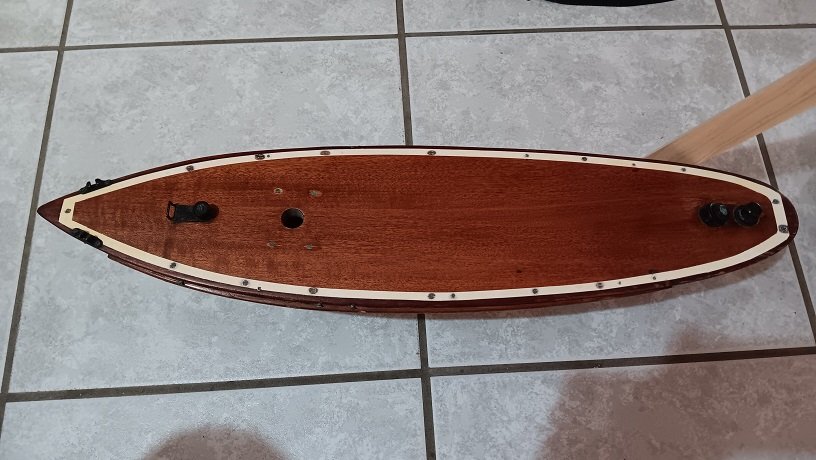-
Posts
1,285 -
Joined
-
Last visited
Content Type
Profiles
Forums
Gallery
Events
Everything posted by Bedford
-
I've been asked to restore a lovely old pond yacht for display in a local yacht club. It's beautifully made, the hull is carved from a solid piece of mahogany hollowed out and the deck is another piece of mahogany. Perfectly fitted and screwed down around the margins. I have no experience with pond yachts so I'm looking for some help with the details. Specs are:- L.O.D. 668mm - 26 1/4" Beam 160mm - 6 1/4" Mast 843mm - 33 3/16" with lower shroud mast band at 315mm - 12 3/8" high and upper shroud/stay mast band at 618mm - 24 5/16" high Boom 493mm - 19 3/8" Bowsprit is missing So the questions so far:- The rigging left in the mast suggests she was a fractional sloop but I'm not sure if she would have been gaff or Bermudan rigged. There are still two haly'ds at the top of the mast but it looks like there could have been three. How long should the bowsprit be, its heel, for want of a better word, is 114mm - 4.5" aft of the bow. There are two sheet horses, each running the width of the deck. 1 for the jib and one for the main. Might she have a club footed jib. There is no "comb" for setting the tiller and it has no holes in it or any indication it had things connected to it. How did it steer. I don't need to get her back to true sailing condition but I'd like her to look as close as possible to original and I'm hoping they don't want her stripped back and refinished because she's in gorgeous aged condition.
-
She's looking beautiful Mark I prefer the glue first paint later approach as it's easier to get them positioned properly as you said and easier to glue them on. Masking tape works well and can even be placed on the later painted surface to protect it from fine detail sanding of any paint that bleeds under the tape onto the sponson
-
As you know, I'm no expert in the field of quadrireme design or use so take this however you chose. I own a 15 foot Tammie Norrie, a beautiful rowing/sailing dinghy with a bit much freeboard for rowing in windy conditions so I deploy the rudder in such instances. My oars are 8 feet long so the motive force is at two points 16 feet apart in the water. That's a lot of leverage applied by each oar. To overcome that leverage with a rudder is not easy. I can tell you from experience that the boat can not follow the arc set by the rudder while being rowed. It goes straight and then when oars are lifted for the back sweep it takes the rudder a second or so to overcome the straight line momentum before imparting its influence on the direction of the boat. The boat traces an almost porpoising action but on the horizontal plane. This is with a full scale rudder in full scale conditions. Another way to look at it is as a drag car. Imagine a locked differential driving two tyres 4 feet wide and trying to steer with 4 inch front wheels. It ain't going to happen. The only way I can steer my boat in an arc is by altering the power I apply to the inboard oar and shortening the stroke. So as I see it you either reprogram to achieve this or make MUCH BIGGER rudders.
- 536 replies
-
- Quadrireme
- radio
-
(and 1 more)
Tagged with:
-
Keith, I don't think you'll have too much trouble making the ply conform as long as the curves aren't too great. We are building a 16 foot sailboat at the boatshed and it's got 6mm ply sheeting that has to bend two ways to meet the curve of the chine. The big thing is being able to pull it in and clamp it effectively and using the right glue. I suppose you've already considered the joint between the two lengths of ply but in case you haven't I'd be using a scarf joint rather than a butt joint to make the joint easier to hide.
-
Congratulations, a very long project with incredible attention to detail. A masterpiece! What's next I wonder...
-

1876 Parcel van by michael mott
Bedford replied to michael mott's topic in Non-ship/categorised builds
Beautifully executed, I love it! -

1876 Parcel van by michael mott
Bedford replied to michael mott's topic in Non-ship/categorised builds
I'll follow this one, I love a scratch build mechanical model and you'll come up with some very interesting processes no doubt -
Always a pleasure to have you back onboard Michael
- 2,207 replies
-
The Sutton Hoo ship is very interesting Keith. I'm a member of Lake Macquarie Classic Boat Assoc. we are a similar bunch of "old codgers" who build and restore classic boats but not to that scale or degree of authenticity. I think groups like that are always welcoming and happy to discuss their work. I can definitely appreciate the amount of waste that would occur cutting their strakes that way but it's authentic.
-
I think Mark is onto it but the vertical lever is the tiller (side steering) and the half inch rod is a keeper rail to protect it. So bent to 90deg at each end and into the carlin or coaming so the tiller is captive. I'd guess side steering was the ideal method for a small fishing boat as it leaves the cockpit and the other side of the boat clear to work.
About us
Modelshipworld - Advancing Ship Modeling through Research
SSL Secured
Your security is important for us so this Website is SSL-Secured
NRG Mailing Address
Nautical Research Guild
237 South Lincoln Street
Westmont IL, 60559-1917
Model Ship World ® and the MSW logo are Registered Trademarks, and belong to the Nautical Research Guild (United States Patent and Trademark Office: No. 6,929,264 & No. 6,929,274, registered Dec. 20, 2022)
Helpful Links
About the NRG
If you enjoy building ship models that are historically accurate as well as beautiful, then The Nautical Research Guild (NRG) is just right for you.
The Guild is a non-profit educational organization whose mission is to “Advance Ship Modeling Through Research”. We provide support to our members in their efforts to raise the quality of their model ships.
The Nautical Research Guild has published our world-renowned quarterly magazine, The Nautical Research Journal, since 1955. The pages of the Journal are full of articles by accomplished ship modelers who show you how they create those exquisite details on their models, and by maritime historians who show you the correct details to build. The Journal is available in both print and digital editions. Go to the NRG web site (www.thenrg.org) to download a complimentary digital copy of the Journal. The NRG also publishes plan sets, books and compilations of back issues of the Journal and the former Ships in Scale and Model Ship Builder magazines.

